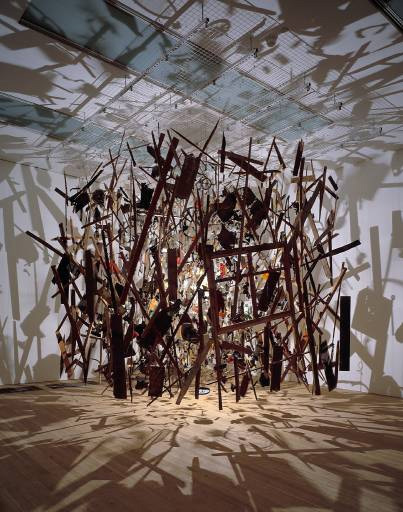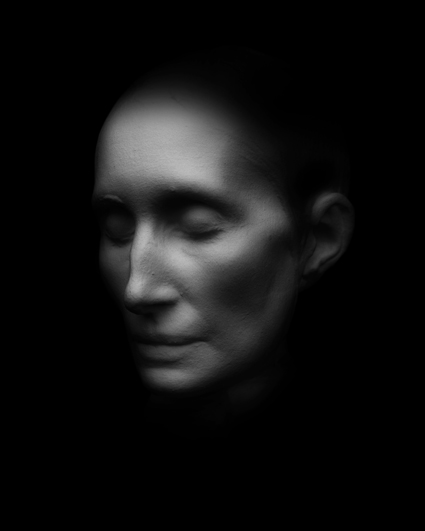A Mighty Big If
Hits: 331405 May 2011
Sam Burcher goes to Bloomsbury for an evening of music, art and entertainment.
 Last Thursday, I had the pleasure of attending Richard Strange’s (frontman of Cabaret Voltaire, writer and broadcaster) delightful soiree at the Chapel of the House of St Barnabas in Soho, where he was talking to Richard Jobson (The Skids, writer and film director) and Cornelia Parker OBE (creator of the exploding shed as art).
Last Thursday, I had the pleasure of attending Richard Strange’s (frontman of Cabaret Voltaire, writer and broadcaster) delightful soiree at the Chapel of the House of St Barnabas in Soho, where he was talking to Richard Jobson (The Skids, writer and film director) and Cornelia Parker OBE (creator of the exploding shed as art).
A Mighty Big If is officially billed as being at number one Greek Street. But, in reality, the entrance to the gold-infused chapel is secreted on Manette Street, an unpretentious thoroughfare that joins Greek Street to Charing Cross Road.
The intrigued congregation, sitting comfortably on chiavari chairs in the chilly chapel under the high sweeping arches and alabaster pillars, were treated to much deeper insights into these creative minds than Wikepedia thought possible thanks to Richard Strange’s intimate questions. This arrangement works so much better than a ‘straight’ lecture.
Cornelia Parker
 For example, if Richard Strange hadn’t pushed the boundaries, how would we have known that Cornelia Parker’s father sufferered from Crohn’s disease and never had a girlfriend until the age of 33, when he met her mother, a Luftwaffe nurse, who worked in a hospital in Cheshire after the war. Until then, her father had been written off and expected to die, but lived until he was 87 years old.
For example, if Richard Strange hadn’t pushed the boundaries, how would we have known that Cornelia Parker’s father sufferered from Crohn’s disease and never had a girlfriend until the age of 33, when he met her mother, a Luftwaffe nurse, who worked in a hospital in Cheshire after the war. Until then, her father had been written off and expected to die, but lived until he was 87 years old.
Cornelia Parker’s fascination with dust and feathers led her not to an allergy, but to the art installation called The Maybe, that featured the actress Tilda Swinton, (famous for her film role as Virginia Woolf’s Orlando) as herself. Swinton slept in a glass case for a week surrounded by rarefied objects added by Parker, such as a feather from Sigmund Freud’s psychotherapy couch, Churchill’s half smoked cigar, Dickens's quill, and the dust from spices left in the snow hut after Scott’s doomed South Pole expedition.
In Parker’s mind, feathers have reached far loftier heights in Sir Ranulph Fiennes sleeping bag ascending Everest or crossing the Antarctic than they ever could by remaining attached to birds. After all, it’s far too cold at the top of the world for our feathered friends, she said. Her beautiful photograms brought by the Government Art Collection of solitary feathers such as Feather from a Wandering Albatross expressing the continuum of a feather once separated from its bird host.
Better known is Parker's passion for explosions, which she says comes from her love of friction and making extant things behave differently. In 1991, she persuaded the army to blow up a common or garden shed, suspending the pieces of Cold Dark Matter, An Exploded View in the Tate Modern. She also has a thing about string, and wrapped a mile of it around Rodin’s Kiss to make an entirely new work called The Distance (a kiss with string attached).
Her next new work is a version of the Little Mermaid, like the one in Copenhagen, except that Cornelia Parker’s mermaid will sit in Folkestone harbour and is modelled on a local woman.
Richard Jobson
A neat segue to the next speaker was supplied by Richard Strange, who performed a rolling and sonorous version of Lou Reed’s Pale Blue Eyes. Strange’s rich tones and sheer presence contrasting with the unique, but wavering sound of Reed.
Richard Jobson took up the thread by telling an entertaining story about how he got clearance to use Pale Blue Eyes in his film Sixteen Years of Alcohol. Jobson explained that years ago while he was still in The Skids and touring America, he received a telephone call from Reed asking him in a “whiny voice”, which he mimicked, if his band would play his birthday party. The Skids did the gig, but they never got paid.
By his own admission, Richard Jobson is a terrible one for holding a grudge so, when he learned that music copyright clearance on Pale Blue Eyes would cost him $80,000, he phoned Lou Reed and reminded him about his old debt to him. In the end, Jobson paid just $800 for the track, which was his fee for playing Reed’s party all those years ago. Jobson laughed and said that Brian Ferry gave him clearance on his song Love is a Drug for the same cheap price.
The audience was treated to snippets of The Skids anthems Into the Valley and The Saints are Coming. I was so impressed with the visceral power of the latter song, that in 1978, I scrawled the opening lyrics on the toilet wall at school whilst smoking a cigarette and bunking off assembly. It still sounds good today. We also heard the India Song from Richard Jobson’s time in Cabaret Futura, which sounds so different, but springs from the same creative source, he said.
Richard Strange challenged the audience, “How many of you know the lyrics to Into the Valley?” he asked, drawing a blank aside from the chorus of “Ahoy, Ahoy!,” which we chanted spontaneously in the chapel, and afterwards in the street, conjuring up the spirit of 1979, for just a moment. Richard Jobson obliged us by reciting the whole song, revealing its richly poetic landscape embracing “land, sea and sky,” and his cynicism about the disease of war.
The Somnambulists
 The Iraq war is the subject of Richard Jobson’s latest film venture called The Somnambulists. The title is based on a series of photographs of life and death masks of both well-known and unknown people documented in a book of the same name by Joanna Kane, and recently displayed at the Scottish National Portrait Gallery.
The Iraq war is the subject of Richard Jobson’s latest film venture called The Somnambulists. The title is based on a series of photographs of life and death masks of both well-known and unknown people documented in a book of the same name by Joanna Kane, and recently displayed at the Scottish National Portrait Gallery.
The film explores fifteen case studies of servicemen and women who saw action in Basra. But it is us, not them who were sleeping through the war. It is us, the audience, whose apathy in the run-up to the war did nothing to prevent the destruction of hundreds of thousands of innocent civilian Iraqi lives. Who can forget the feeling of utter helplessness watching the televised bombing of Basra and Baghdad in the sickening and eerie green-glow of the night cameras?
Another of Richard Jobsons’s current film ventures is the sequel to Quadraphenia, which I can’t wait to see. The original made thirty years ago around the time that he and I were going out together as friends.
It is clear that his ambition, confidence and fearlessness is undiminished, and that his agile mind switches from religion, to poetry, to film, to art with ease. What I didn’t know, was that his upbringing was both Catholic and Communist, or just how much that had influenced his versatile and charismatic skill-set.
Jobson's childhood certainly gave him a love of cinema and film. And, he talked candidly about his hopes for kids from drug-ridden towns and cities in Scotland where all three generations of the same family; grandparents, parents and children are addicts. He believes that teenagers need to learn "commitment" if they are to fully take hold of artistic and other aspirations for themselves.
A Mighty Big If is a night to remember. I caught up with other film-loving friends like “cheeky” Sara Neighbour, the set decorator on Bend in Like Beckham, who I hadn't seen in twenty years. We sat together in the chapel and later laughed and chatted in the courtyard garden under the plane trees and in the crimson-lit bar room in the strangely beautiful House of St Barnabas, the home of the fictional Dr Mannette in Dickens A Tale of Two Cities, who bestowed his name on the street, formerly known as Rose Street, a meeting place for real-life radicals and leaders since 1870.








